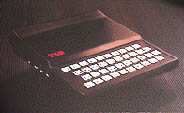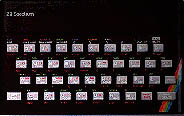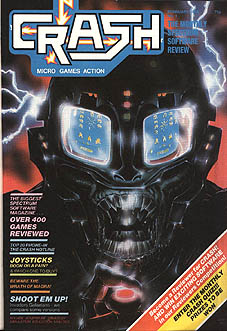
A Spectrum
History Lesson:
(or the bluffers guide
to the Spectrum)

SIR CLIVE SINCLAIR
- Sinclair started by Sir Clive Sinclair (an inventor from England) who also invented the electric powered C5 mobile vehicle in the early 80's.

THE C5
- Prior to 1982, the
ZX80 & ZX81 home computers were released. The ZX81 had an 8K BASIC
ROM,
1 (yes, one!) K of
RAM upgradable to 16K.

THE ZX81
- Amid competition of other home computers (Jupiter, Vic 20, Apple II, BBC Micro, Dragon and early games consoles) the release of the ZX Spectrum.
Specs: 3.5mhz Z80A
processor
In built BASIC interpreter
and operation system
16K RAM (upgradable
to 32/48K)
256 x 192 pixel screen
with 8 colours (normal or extra bright and flash)
1 channel sound :
Internal speaker and mic for external loudspeaker

THE ZX SPECTRUM
- Storage devices included
tape cassettes and micro drives. You could connect up to 8 micro drives
with storage of 100K
per floppy and an access time of 3.5 seconds.

MICRO DRIVES
- Joysticks available were the Kempston and Interface 2 compatible joysticks. Along the way, there was the Spectrum Mouse, infamous Spec Drum, the Light Pen, Trick Stick, sound samplers and printers.

THE VERY SMALL SPECTRUM PRINTER (TOILET ROLL JOKES AHOY)
- Release of the 'business machine'; the Sinclair QL in 1984/85.
QL specs (advanced
for the time but the QL never really took off)
32-bit Motorola 68008
processor
Intel 8049 controller
chip
128K RAM (expandable
to 640K)
QDOS Operating System
supporting multi-tasking
2 in built micro drives

THE SINCLAIR QL
- Release of the Spectrum+
(in a larger more hardy casing - no more rubber keys!)
There was the 48K
and 128K model.

THE SPECTRUM+
- A raging competition between the home computer market leaders Commodore, Sinclair and Amstrad started around 1985 onwards. Internally, there was the war of the computer magazines, namely Crash, Sinclair User and Your Sinclair.

THE VERY FIRST ISSUE
OF CRASH MAGAZINE (FEB 1984/75p)
- Amstrad buys the
rights to Sinclair and in 1986 releases a re-vamped model:
The Spectrum +2 (released
in 2 versions due to problems with the built in tape deck on version 1).

THE SPECTRUM +2
- Amid the interest
in new, next generation home computers (mainly Amiga and Atari machines)
Amstrad
release the Spectrum
+3 which only had a built in disk drive as an 'upgrade'. Otherwise it was
technically
identical to the +2
released several years earlier in 1986 and far inferior to the capabilities
of the Amiga and
Atari at the time.

THE SPECTRUM +3
- The Spectrum saw
a surge in software production from 1983 onwards, probably riding a peak
between
1987 and 1989. Many
of todays big name software houses began on the humble Spectrum. Ocean,
Activision, Gremlin, Probe. By 1990, thanks to this wave of software and
user support, big name titles were still
being released. One
of the last 'big' titles was probably 'Street Fighter 2' (US Gold) in 1992.

THE SAM COUPE
- The ill-fated Sam
Coupe was the last hope at resurrecting the Spectrum line. Marketed by
Miles Gordon Technology, it was meant to be a logical progression for Spectrum
upgraders. However, it was a bit of 'too little, too late' because many
people had already upgraded to Amiga's and Atari's and the Sam Coupe didn't
even
offer as much power
and more importantly software support as the aforementioned machines. The
Sam Coupe was released in 1989 and basically died by early 1991due to MGT
liquidating; although a following did begin.

JET SET WILLY - the famous platform game - CASSETTE COVER
